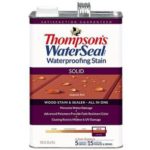Both paints and stains protect wood from decay and damage caused by sun, rain, humidity and insects. However, there are many differences between the two finishes.
Do you need to paint or stain your deck? Or, do you just want to update its color? No matter the reason, this article can help you determine which material (painting vs. wood stain) is best for your needs.
Staining is More Economical Than Paint
Over time, the wood will gray due to weathering. Although you may be able to re-coat your deck with paint, you won’t be able to change the color of natural wood.
That’s why most people choose stain instead of paint — it allows for simple touch-ups that maintain the wood’s character and color. It also is a far more cost-effective solution.
The best exterior deck stain withstands UV rays and rain damage while creating a beautiful sheen that is duller than glossy paint finishes.
Stain Allows You to Keep a Natural Look
It is not uncommon to see old painted decks that are peeling and faded. A deck that has been painted may also have minor imperfections that detract from its appearance. If you want to make the most of an older deck and help it blend into its surroundings, a solid wood stain is the best choice for a deck resurfacing project.
Once properly applied, a solid wood stain will minimize many minor imperfections in the wood while still allowing you to keep many of the natural markings present in the wood’s grain.
If you’re a fan of the natural, rusty look of weathered wood but want the durability and minimal upkeep that comes with a glossy, smooth finish, then a solid wood stain is your best bet.
Solid wood stains are essentially water-based paint for your decking boards and can be used to both camouflage dark streaks or knots and rejuvenate weathered boards.
Easier to Apply Stain
Applying stain directly is also easier than painting, as paint can be prone to run and requires several coats to get an even color.
Stain is more flexible than paint in that it can be applied directly to wood without requiring a primer. But while stain is transparent, it still penetrates wood slightly, allowing it to fade over time.
Paint Offers More Variety of Colors
Paint has the advantage of being available in a variety of colors, while wood stains are limited to options that complement the natural hues of lumber.
With a paint job, you can easily choose any color or shade from your favorite palette to achieve the look you want. With wood stain, the tones and shades are typically limited to clear varieties or deep brown tones that mimic the wood’s natural qualities.
Painted wood can look brand new or it can be made to look antique (the worn kind of antique, not the disgusting kind). Staining tends to exaggerate the flaws in your wood which means you’ll want a deck that’s in good shape before you try to stain it.
If you have a great deck and want to accentuate its innately beautiful qualities, painting is your best bet.
Painting Lasts Longer
Painting a deck with paint rather than stain could save you thousands of dollars over time, in part because many stains require frequent re-application. It’s possible to recoat or refinish decks every five to seven years where paint lasts 10 years or more on average.
Painting your deck is cheaper and easier than using wood stains. You can enjoy a fresh new look without spending the time and energy needed for stain applications every spring and summer.
Easier to Maintain Paint
As a general rule, it’s easier to maintain paint than it is to maintain stain. Paint dries to a slick surface that makes sweeping away dust and dirt easy and fast.
Stain leaves the wood grain visible and renders it more vulnerable to damage from rain, moisture, and foot traffic.
Final Thoughts
Both stain and paint provide long-term protection for your deck against moisture damage. However, homeowners have a personal preference either in terms of aesthetics, technique, and maintenance.
Painting vs. staining a deck is a common debate, but the decision is easy to make: it’s all about what works best for your home and lifestyle.



